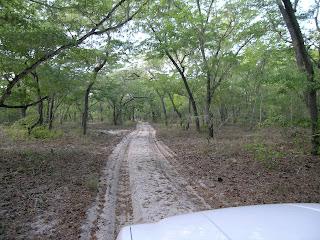This story about my jaunt to Mozambique was published in the 31 October/1 November 2009 issue of The Weekender.

We had left the beaches of Chidenguele in the morning, heading to Hyliota Camp, a rustic birding camp on one of Mozambique’s freshwater inland lakes in Inhambane Province. Before we confirmed our booking, we had prevailed upon the manager in SA that we didn’t need him or anyone else to guide us there. And we had no need for GPS co-ordinates as we didn’t have a GPS.
His written directions provided a few laughs, but not much clarity. Still, how could we go wrong — a Portuguese-speaker and a highly qualified South African field guide, enhanced by the vital talents of a retired CIA economist and a high-powered corporate coach from Washington, DC. We sought a path less travelled to a destination often ignored.
Already we had made our way on unmarked roads and dirt tracks for about 130km to villages that seemed to be Manjacaze and Macuca. About 25km further, we hoped this was Marão/Mawaela, the last place to find anyone who might have some helpful information, and hence the last opportunity for our Portuguese-speaker to be of any value.
We then followed the written directions for the last 35km: “Turn into a two track road left at the pole fence as you come into the village the road make a 90 degree turn to the right at the fence.” Uncertainty brewed dissension.
If we were indeed on the right track, the open savannah in the instructions would get thicker and we’d be into miombo woodlands. Soon we’d be passing through a big, open clearing in an ironwood forest, looking for a “road fork there take the one to the right not well used a marula tree on left of the road with arrow on trunk pointing right the track go in between to dead trees 10m from main track ”.
Verbal advice had offered more — we’d stumble upon an old axle at this point.
The windy track of deep sand took us from savannah to woodland, yes, but where was the big open clearing with the all-important marula tree? At each of the several open clearings that looked “big”, we pondered (often quite vehemently): there’s a marula tree without an arrow, wait, this is not really a clearing, stop, is this woodland or forest, whoa, shouldn’t we turn back now while we have a chance?
No vehicle had passed this way for many weeks. If we punctured a tyre, we could change it, but if we punctured a second one or had any other vehicle trouble, who among us was going to walk more than 50km to look for help that was unlikely to be available?
Certainly not our field guide who had counselled retreat long before this point. Foolhardy we were, onward we moved, discordantly we spoke.
When we weren’t sparring with each other, we could appreciate the changing habitat of open plains, a few dry river crossings, and mixed woodlands. And when you’re in a low 4x4 for nearly an hour, it is easy to look closely at every marula tree, even as we were unsure we were in the right place.
Finally, we spotted the tree with the arrow. We stepped out for a closer look and before long spied the rusted iron axle on the ground. With great earnestness, we spread out on foot in the arrow’s direction, seeking the two dead trees that would take us to the “not well used” track. Among so many dead trees, we never found the true ones. Regardless, our CIA representative advised that “in these circumstances anything that looks remotely like a track is hardly lesser used than any other”.
Among so many dead trees, we never found the true ones. Regardless, our CIA representative advised that “in these circumstances anything that looks remotely like a track is hardly lesser used than any other”.
Uncertainty was now palpable, discord on the rise.
An hour later, a shimmering lake came into view. Was it Lago Shankoz, the lake named in our written directions? Perhaps it was Lago Nhangulaze, the locally used name for this lake, but which we found later on Google Earth to be nearly 25km away as the Pygmy goose flies.
No matter, our corporate coach led our laughter of relief as we found the camp.
Ricardo, the caretaker, appeared as promised. He was, however, unprepared for guests; two months advance booking was apparently not enough to get word to him. He quickly put a pump in the lake to provide water for the so-called ablution facilities.
He introduced us to the two dark and disordered, reed-walled, thatched huts. To protect us from mosquitoes, we were to sleep inside a zipped pup tent pitched in and dominating the small, windowless bedroom. On low-slung, drooping cots. And oh, the linen on the sagging , ratty mattresses!
In fairness, the adjacent lapa kitchen and braai area were adequate for our culinary requirements. It had basic utensils and a prep area, though the freezer lacked any power source.
The appeal of the lake itself, about 800m across at this point (and about 4km long), was its isolation. Our exploratory walk revealed the spoor and dung of elephant, purportedly on the move from the Kruger.
Somewhere in the vicinity was a population of the rare Olive- headed Weaver and even rarer Hyliota bird , but they didn’t make themselves available for us.
Our route the next day from the camp to a tar road had no landmarks to look for nor turns to make, and thus no ambiguity to confront. By evening, we were in Inhambane on the Indian Ocean, 180km away.
South Africans are rediscovering Mozambique as a very different Africa close to home. We were searching for an adventure that Mozambique’s name alone conjures up. We looked for a low-risk experience, a journey that would provide us with at least one tale to tell. We found it.